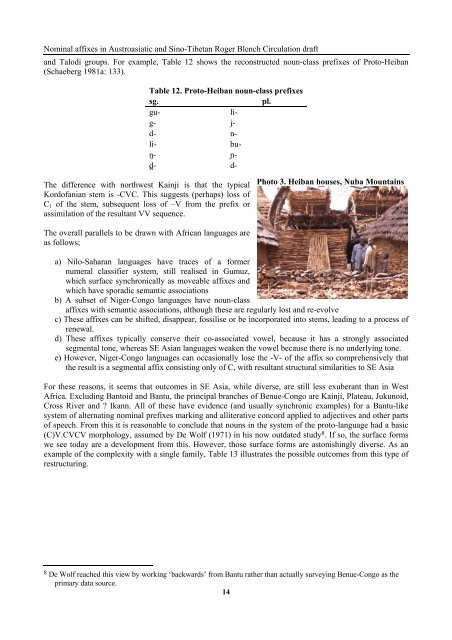The origins of nominal affixes in Austroasiatic and ... - Roger Blench
The origins of nominal affixes in Austroasiatic and ... - Roger Blench
The origins of nominal affixes in Austroasiatic and ... - Roger Blench
You also want an ePaper? Increase the reach of your titles
YUMPU automatically turns print PDFs into web optimized ePapers that Google loves.
Nom<strong>in</strong>al <strong>affixes</strong> <strong>in</strong> <strong>Austroasiatic</strong> <strong>and</strong> S<strong>in</strong>o-Tibetan <strong>Roger</strong> <strong>Blench</strong> Circulation draft<br />
<strong>and</strong> Talodi groups. For example, Table 12 shows the reconstructed noun-class prefixes <strong>of</strong> Proto-Heiban<br />
(Schaeberg 1981a: 133).<br />
Table 12. Proto-Heiban noun-class prefixes<br />
sg.<br />
pl.<br />
gu-<br />
lig-<br />
j-<br />
d- n-<br />
li-<br />
buŋ-<br />
ɲ-<br />
d̪ - d-<br />
<strong>The</strong> difference with northwest Ka<strong>in</strong>ji is that the typical<br />
Kord<strong>of</strong>anian stem is -CVC. This suggests (perhaps) loss <strong>of</strong><br />
C 1 <strong>of</strong> the stem, subsequent loss <strong>of</strong> –V from the prefix or<br />
assimilation <strong>of</strong> the resultant VV sequence.<br />
Photo 3. Heiban houses, Nuba Mounta<strong>in</strong>s<br />
<strong>The</strong> overall parallels to be drawn with African languages are<br />
as follows;<br />
a) Nilo-Saharan languages have traces <strong>of</strong> a former<br />
numeral classifier system, still realised <strong>in</strong> Gumuz,<br />
which surface synchronically as moveable <strong>affixes</strong> <strong>and</strong><br />
which have sporadic semantic associations<br />
b) A subset <strong>of</strong> Niger-Congo languages have noun-class<br />
<strong>affixes</strong> with semantic associations, although these are regularly lost <strong>and</strong> re-evolve<br />
c) <strong>The</strong>se <strong>affixes</strong> can be shifted, disappear, fossilise or be <strong>in</strong>corporated <strong>in</strong>to stems, lead<strong>in</strong>g to a process <strong>of</strong><br />
renewal.<br />
d) <strong>The</strong>se <strong>affixes</strong> typically conserve their co-associated vowel, because it has a strongly associated<br />
segmental tone, whereas SE Asian languages weaken the vowel because there is no underly<strong>in</strong>g tone.<br />
e) However, Niger-Congo languages can occasionally lose the -V- <strong>of</strong> the affix so comprehensively that<br />
the result is a segmental affix consist<strong>in</strong>g only <strong>of</strong> C, with resultant structural similarities to SE Asia<br />
For these reasons, it seems that outcomes <strong>in</strong> SE Asia, while diverse, are still less exuberant than <strong>in</strong> West<br />
Africa. Exclud<strong>in</strong>g Bantoid <strong>and</strong> Bantu, the pr<strong>in</strong>cipal branches <strong>of</strong> Benue-Congo are Ka<strong>in</strong>ji, Plateau, Jukunoid,<br />
Cross River <strong>and</strong> ? Ikann. All <strong>of</strong> these have evidence (<strong>and</strong> usually synchronic examples) for a Bantu-like<br />
system <strong>of</strong> alternat<strong>in</strong>g <strong>nom<strong>in</strong>al</strong> prefixes mark<strong>in</strong>g <strong>and</strong> alliterative concord applied to adjectives <strong>and</strong> other parts<br />
<strong>of</strong> speech. From this it is reasonable to conclude that nouns <strong>in</strong> the system <strong>of</strong> the proto-language had a basic<br />
(C)V.CVCV morphology, assumed by De Wolf (1971) <strong>in</strong> his now outdated study 8 . If so, the surface forms<br />
we see today are a development from this. However, those surface forms are astonish<strong>in</strong>gly diverse. As an<br />
example <strong>of</strong> the complexity with a s<strong>in</strong>gle family, Table 13 illustrates the possible outcomes from this type <strong>of</strong><br />
restructur<strong>in</strong>g.<br />
8 De Wolf reached this view by work<strong>in</strong>g ‘backwards’ from Bantu rather than actually survey<strong>in</strong>g Benue-Congo as the<br />
primary data source.<br />
14
















